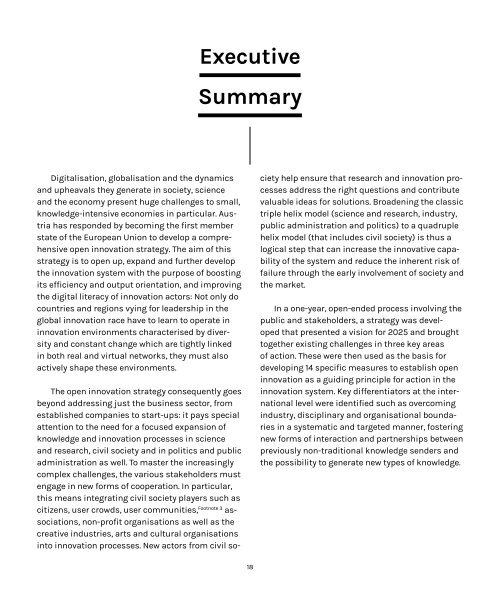Strategie für Österreich
Open-Innovation-barrierefrei
Open-Innovation-barrierefrei
Erfolgreiche ePaper selbst erstellen
Machen Sie aus Ihren PDF Publikationen ein blätterbares Flipbook mit unserer einzigartigen Google optimierten e-Paper Software.
Executive<br />
Summary<br />
ciety help ensure that research and innovation pro-<br />
cesses address the right questions and contribute<br />
valuable ideas for solutions. Broadening the classic<br />
triple helix model (science and research, industry,<br />
public administration and politics) to a quadruple<br />
helix model (that includes civil society) is thus a<br />
logical step that can increase the innovative capa-<br />
bility of the system and reduce the inherent risk of<br />
failure through the early involvement of society and<br />
the market.<br />
In a one-year, open-ended process involving the<br />
public and stakeholders, a strategy was devel-<br />
oped that presented a vision for 2025 and brought<br />
together existing challenges in three key areas<br />
of action. These were then used as the basis for<br />
developing 14 specific measures to establish open<br />
innovation as a guiding principle for action in the<br />
innovation system. Key differentiators at the inter-<br />
national level were identified such as overcoming<br />
industry, disciplinary and organisational bounda-<br />
ries in a systematic and targeted manner, fostering<br />
new forms of interaction and partnerships between<br />
previously non-traditional knowledge senders and<br />
the possibility to generate new types of knowledge.<br />
Digitalisation, globalisation and the dynamics<br />
and upheavals they generate in society, science<br />
and the economy present huge challenges to small,<br />
knowledge-intensive economies in particular. Austria<br />
has responded by becoming the first member<br />
state of the European Union to develop a comprehensive<br />
open innovation strategy. The aim of this<br />
strategy is to open up, expand and further develop<br />
the innovation system with the purpose of boosting<br />
its efficiency and output orientation, and improving<br />
the digital literacy of innovation actors: Not only do<br />
countries and regions vying for leadership in the<br />
global innovation race have to learn to operate in<br />
innovation environments characterised by diversity<br />
and constant change which are tightly linked<br />
in both real and virtual networks, they must also<br />
actively shape these environments.<br />
The open innovation strategy consequently goes<br />
beyond addressing just the business sector, from<br />
established companies to start-ups: it pays special<br />
attention to the need for a focused expansion of<br />
knowledge and innovation processes in science<br />
and research, civil society and in politics and public<br />
administration as well. To master the increasingly<br />
complex challenges, the various stakeholders must<br />
engage in new forms of cooperation. In particular,<br />
this means integrating civil society players such as<br />
citizens, user crowds, user communities, Footnote 3 associations,<br />
non-profit organisations as well as the<br />
creative industries, arts and cultural organisations<br />
into innovation processes. New actors from civil so-<br />
18


